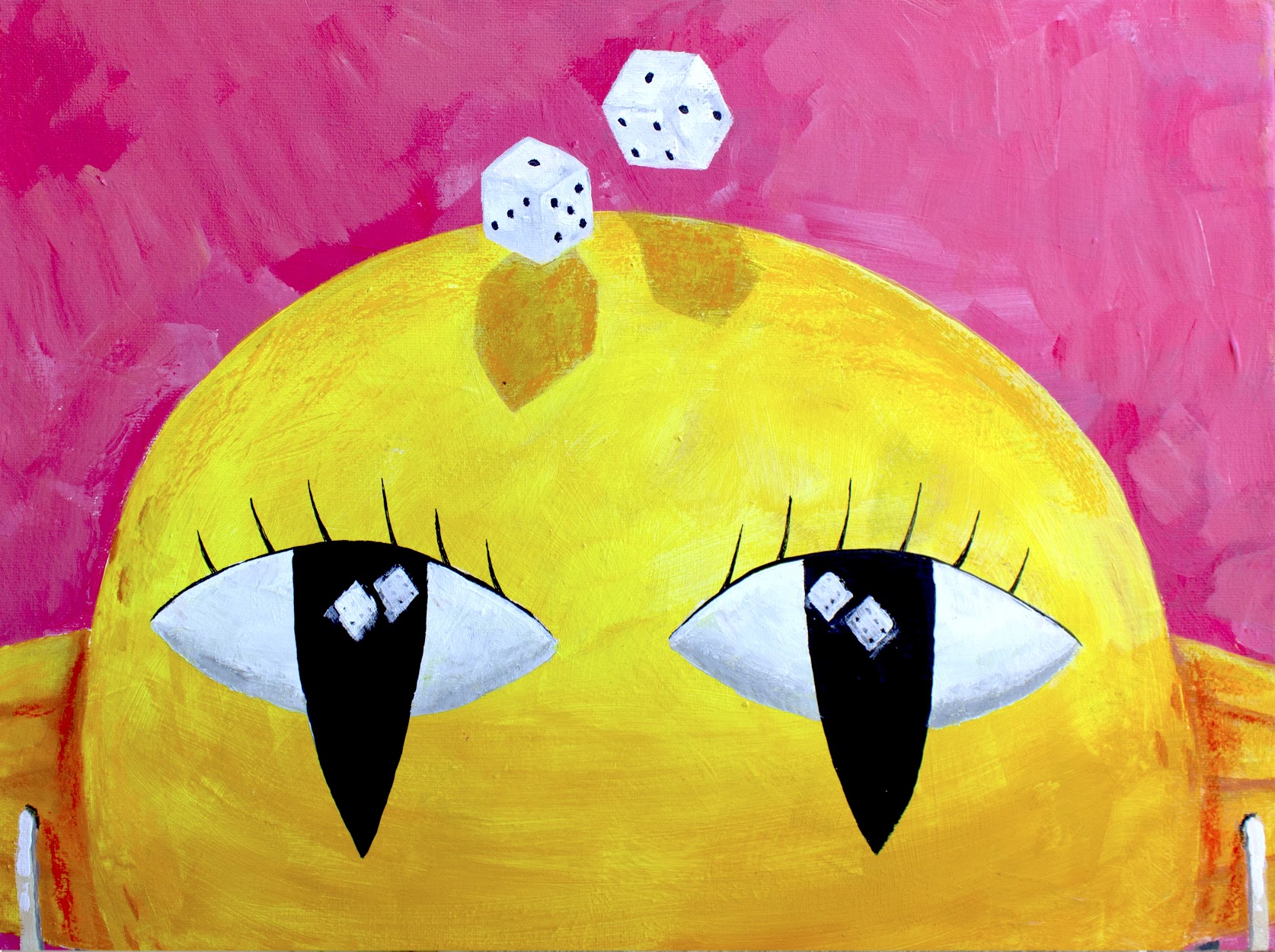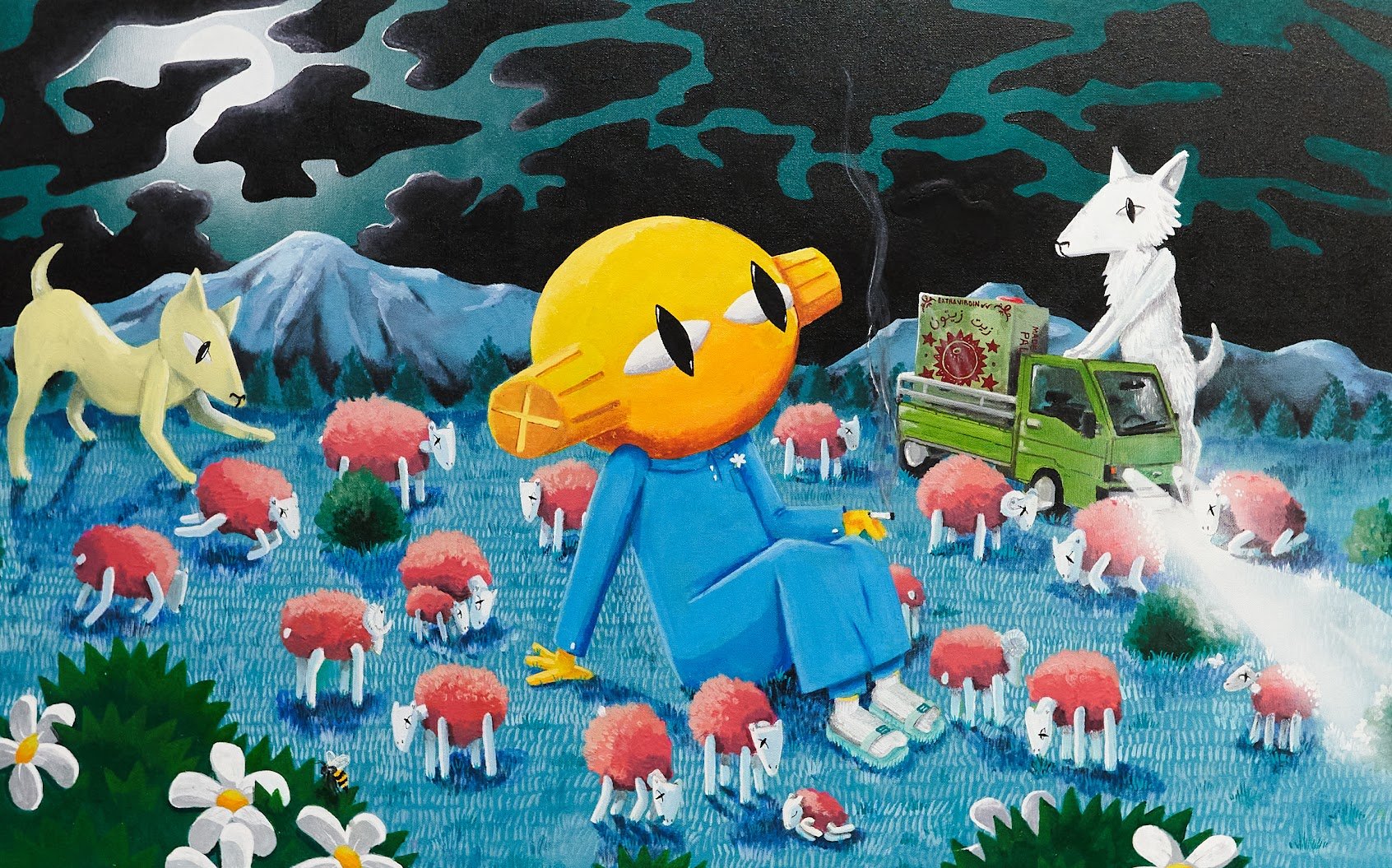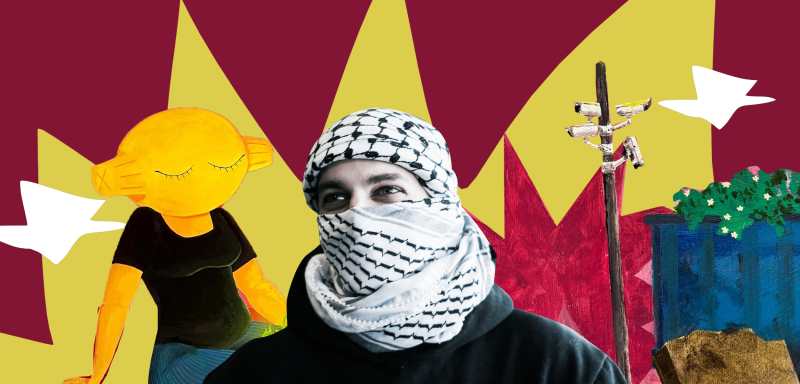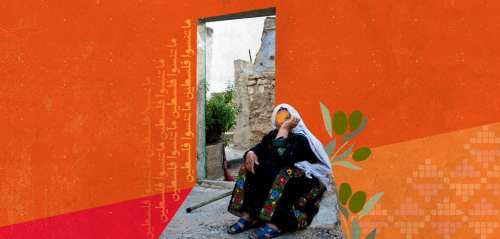Down a winding street in Jordan’s mountainous capital, nestled between residential buildings and coupled alleyways, Naji AlAli instructs to look out for what he calls “the giant lemon.”
In the heart of Amman, overlooking one of its highest points, a giant lemon—Lemonback—is painted on the dead-end stone canvas of an Ottoman-era building, staring ominously at the entrance where AlAli’s studio is located. “People mainly comment on how my character’s eyes are drawn top to bottom,” Naji adds as he walks towards the entrance, “that means my characters see more than the average human.”
 "Roll Your Dice" (2023) is an oil and acrylic piece from Naji AlAli. (Courtesy of the artist).
"Roll Your Dice" (2023) is an oil and acrylic piece from Naji AlAli. (Courtesy of the artist).
"Roll Your Dice" (2023) is an oil and acrylic piece from Naji AlAli. (Courtesy of Naji AlAli)
In 2024, Naji showcased his artwork at two separate exhibitions: “Key West” in April and “Fawda,” or chaos, in September at Q0de in Jabal Amman.
AlAli is named after the revolutionary political cartoonist and journalist who drew Handala, the famous 1969 depiction of a child idling with his hands behind his back. The caricature represents the 1948 Nakba, the displacement of Palestinians across historic Palestine. Found on works of art, countless murals, and the symbol of the Boycott, Divest and Sanction movement (BDS), Handala's back is turned to the audience in rejection of foreign intervention and its complicity with the Israeli occupation. Although Al-Ali was assassinated in 1987, he remains immortalized within the lines of Handala’s ode to resistance.
Twelve years after the artist’s death, 25-year-old Naji was born to Palestinian parents originally from northern Jenin, or Arraba Jenin. Fueled by the Israeli occupation and Palestinians’ ongoing battle with the colonial West, Naji’s art serves as a reminder of Palestine’s claim to sovereignty.
Palestine has a rich agricultural history, and with it, centuries of indigenous practices of caring for the land have been passed down from generation to generation. By living in Naji’s vision of a free Palestine, Lemonback and its community remind the occupation that its ecosystem is here to stay and prosper.
Like many in the West Bank, Naji’s family was expelled from northern Jenin by the Zionist regime. His characters explore the future that had been stolen from him and his family. “My grandparents left Jenin in the early 1950s and moved to Qatar. At the time, my grandpa was the composer for the Qatari military. They had offered him citizenship, but he rejected it believing that he would be returning to Palestine soon.”
Inspired by his grandfather’s faith in their return, Naji’s fruit utopia illustrates how Palestinians can envision their post-liberation future. “Even in the works about the resistance, I’m not portraying our murder or the struggles we’re going through,” he explains as he settles down on the balcony, the lights of the city now blooming in the distance. “I’m showing what we would look like when we’re liberated. It’s like I broke the door [to the future] and I’m there.”
“Even in the works about the resistance, I’m not portraying our murder or the struggles we’re going through,” he explains as he settles down on the balcony, the lights of the city now blooming in the distance. “I’m showing what we would look like when we’re liberated. It’s like I broke the door [to the future] and I’m there.”
Naji’s art showcases vibrant depictions of personified fruits that represent Palestine’s bustling agricultural industry and inhabit a reimagined utopian world. “I didn't want to do what al-Ali did and focus on the problems we’re facing. I’m doing the complete opposite and looking for solutions,” the young artist told Raseef22.
To differentiate himself from his namesake, he decided to create a world of several citrus protagonists, channeling Palestinian agency through the land’s agricultural oeuvre. Wide-eyed, his characters vary in substance, from tanktop-clad watermelons to politically active figs, freedom-loving oranges, righteous lemons, realist pomegranates, and indigenous olives.
 Naji AlAli's 2023 painting, "Night Shepherd," is acrylic on canvas. (Courtesy of the artist).
Naji AlAli's 2023 painting, "Night Shepherd," is acrylic on canvas. (Courtesy of the artist).
Naji AlAli's 2023 painting, "Night Shepherd," is acrylic on canvas. (Courtesy of the artist)
Each of these characters represents a village in the occupied territories, providing a portrait of a free Palestine, challenging Israel’s greenwashing narratives, including the claim that it was Zionists who “made the desert bloom.” Notably, Lemonback’s existence rejects the occupation’s claim to indigeneity, as it imports and plants European trees across Palestine to replace countless villages demolished throughout the Nakba.
In many of his works of art, Naji’s characters live in a free Palestine, smoking cigarettes on the intersection of Al-Quds and Gaza Street, as portrayed in one of his works, titled Falafel Jenin, which features apartment buildings illuminated across the West Bank’s playful hilltop topography.
 Naji AlAli's 2024 acrylic painting, "Dinner Promises," features the restaurant Falafel Jenin. (Courtesy of the artist).
Naji AlAli's 2024 acrylic painting, "Dinner Promises," features the restaurant Falafel Jenin. (Courtesy of the artist).
Naji AlAli's 2024 acrylic painting, "Dinner Promises," features the restaurant Falafel Jenin. (Courtesy of the artist)
Naji rarely returns to the present. He has refrained from depicting the occupation’s borders, Israeli military tanks, and other symbols of Zionist influence on the land. “I don’t want to give them power; instead, [this series shows] how they look when defeated.”
Naji rarely returns to the present. He has refrained from depicting the occupation’s borders, Israeli military tanks, and other symbols of Zionist influence on the land.
However, in “Fawda,” his exhibition in September 2024, Naji took a new approach in his latest series, connecting resistance to beauty. “Fawda was the first time in my life that I painted something symbolizing the enemy.”
In his latest collection of work, he displays characters with prominent artifacts from the occupation: Israeli bulldozers looming behind a calm and collected Lemonback as she casually exists on the land.
“Lemons represented Palestine to me, but I wanted things that resonated with other Palestinians as well,” he says. “So, I created Lemonback, Tino, Ms. Bateekhah, Zaytoon, and Row to do that. Now at Fawda, I introduced the sunbird and Palestinian gazelle; two animals representing hope, freedom, resistance, and beauty for Palestine.”
During his travels, Naji aims to make art like this wherever he can, from busy intersections in Amman to shopping districts in Charlotte, North Carolina. Having been raised in Qatar and later moving to the United States, Naji takes the opportunity to tag his work wherever he goes. “As an outsider, I should show both Palestinians and non-Palestinians the life we can live when we’re completely free. Whether in Palestine or outside of Palestine, we’re still Palestinian in blood,” Naji urges. “If you’re existing in this world as a Palestinian—if you say the words, I am Palestinian, that’s a political statement in itself.”
“If you’re existing in this world as a Palestinian—if you say the words, I am Palestinian, that’s a political statement in itself.”
AlAli’s world evolved from a single lemon, creating a land flowing with characters tied to Palestine’s ecological significance, representing not only fruit, but the towns and villages that harvest them. In this destined future, Naji creates an ecosystem showcasing defiance through hope.
Lemonback’s growing community of fruits reminds audiences that while Palestine’s past cannot be altered, its future can be. By reaffirming Palestinians' connection to the land, Naji offers a glimpse into its future for audiences, acknowledging the grief of occupation, while bringing the dream of liberation to fruition.
Raseef22 is a not for profit entity. Our focus is on quality journalism. Every contribution to the NasRaseef membership goes directly towards journalism production. We stand independent, not accepting corporate sponsorships, sponsored content or political funding.
Support our mission to keep Raseef22 available to all readers by clicking here!
Interested in writing with us? Check our pitch process here!






